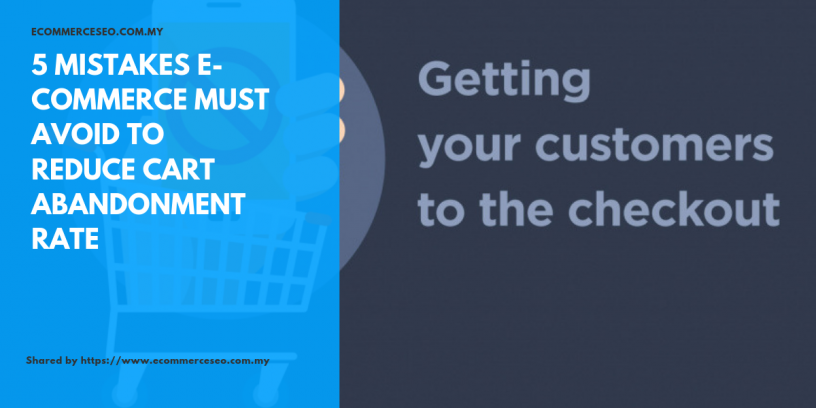Cart abandonment is a marketing emergency! Cart abandonment is comparable to wasted clicks. It drains marketing efforts and yields zero return for companies.
The average abandonment rate is 68% due to increased competition between e-commerce outlets.
Brands should have a very serious approach when dealing with it. We’ll discuss the key reasons behind the surging rate of cart abandonment and how to lower that rate in 2017.
No Urgency to Buy
People visit online shops with expectations that range from finding their desired products to seeing an inexpensive price tag attached to those products. The primary reason for cart abandonment is an expensive price tag. Very few people proceed to buy despite seeing an exorbitant price tag. This way, abandonment rate goes up. The rate could go higher up if the site is new.
Most buyers, almost 90% feel nervous when they visit a new online shop. And many of them expect the price to be cheaper than other e-commerce sites.
Here are some remedial steps that can retain site visitors:
- Coupon code: Coupon codes trigger a sense of urgency. Visitors know they have to buy quickly to redeem the coupon. The immediacy can increase conversion.
- Discount options: Similar to coupon codes, but with few minor differences. Discount options can come in multiple forms such as incentives, giveaways, offer-on-purchase, etc.
- Price comparison: It can show them the commodities are not overpriced. Though this will be of little help if customers have unrealistic expectations.
Separating the extra costs such as shipping fees and taxes is a terrible terrible mistake. Customers get a shocking blow when these costs are added to the final payment.
Long and Tedious Checkout
It’s only partially true that a long checkout process leads to cart abandonment. Being long is not the only spoiler as customers can endure a long checkout process if it has interesting milestones.
Pro Tip: This is where most online shops fail. They seem hellbent on making the checkout process complicated and long. Simplify the checkout process and make it interesting!
Eliminate Account Creation
Online shoppers are largely millennials and they hate to commit. Creating an account is a commitment to prospective customers. To entice them to buy, have shoppers proceed without having to create one.
Outside of millennials, your average shopper will appreciate a short checkout process and are more likely to visit you again if you keep it simple.
Reveal the Progress to Checkout
On long car rides, mile markers are your motivation to keep going and reach the end. Everyone appreciates seeing how far they are to the end of a trip (or a purchase!) Businesses have adapted this progress bar for a wide range of industries from fast food to e-commerce.
With A/B testing for your shopping cart, you’ll be able to see if your customers desire to know how far they have progressed in the checkout process after completing each step. If they do, show them a progress bar like the example below:

Eliminate Unnecessary Information in Early Stages
No need to show customers the quantity, price and total at every stage of your cart. Take a look at the screenshot below:

You can see in the screenshot that the final step in the checkout is “Review Order” where potential buyers will get to see everything split up and the final price. It wasn’t necessary for this information to appear earlier in the shopping experience until the shopper was committed.
Online shops need to identify such unnecessary items and scrap them.
Lack of Payment Options
As many as 8% customers abandon the shopping cart because of a lack of payment options. Customers expect multiple payment methods. An online retailer can lower the cart abandonment rate by having at least four payment options:
- Credit/debit cards
- Mobile payment apps
- Payment gateways
- Online banking
Studies indicate there is a link between the number of payment options and increase in sale. Different customers prefer different payment methods. And it’s not simply a matter of preference, as 25% would leave the checkout process midway if their preferred payment option is not there.
Shoppers want to purchase without having to use their credit/debit card. That’s largely because of security reasons. In fact, the concern for online security is as palpable as 18% customers said they abandon shopping cart because they don’t trust the online shops they visit. Increasing the number of payment methods is not enough, and smart e-commerce retailers need to make sure these methods are fully secure.
Poor Email Marketing Efforts
We know social media marketing benefits e-commerce. Email marketing is even more beneficial as a store owner can approach those who’ve abandoned their carts and make them visit his site again – this time to purchase!
Many e-commerce outlets buy into the preconceived notion that sending abandonment reminders would annoy prospective customers. Nothing can be further from the truth!
A study conducted by Marketing Sherpa showed over 50% believe that sending abandonment reminders are helpful. Nearly 40% believe such emails are vexing but adds that it’s because of the email text, headers, or other content.
Marketing automation tools can fine tune email marketing to increase it’s overall effectiveness and decrease the cart abandonment rate.
Something to keep in mind when choosing the right marketing automation software for you is what tools and features it has to offer you. Marketo, MailChimp, GetResponse, and AWeber, etc. are some of the leading tools for marketing automation.
For example, AWeber has a feature called web form builder, which can prompt cart abandoners to opt-in to a list. This feature of AWeber addresses customer interest and keep them in the bucket of “warm leads.” While GetResponse has a feature solely for lowering cart abandonment rate. It detects the true rate of abandonment and improves it by giving guidelines on how and when to send the emails.
Not using these tools translates to running a backward email marketing campaign which is hardly useful in improving abandonment rate.
Technical Issues and Glitches
A sizable percentage of shoppers abandon their carts because of technical glitches. The common issues include slow loading time, network downtime, broken links and page errors.
The importance of loading time can’t be overemphasized. It’s one factor that can throw a wrench into the most well-crafted sales strategy. Here are some stat figures explaining the importance of loading time for e-commerce outlets:
- Nearly 50% people expect a page to load in two seconds
- If a page takes more than 3 seconds to load, 40% visitors will abandon it
- A delay of one second could lead to the loss of $2.5 million a year
What happens when an e-commerce site shines in all technical areas? The cart abandonment rate dramatically goes down. For example, the Amazon homepage and all other deep pages take only a second to load. (No surprise Amazon’s sales team laughs all the way to the bank.)The best practice would be to make sure there are zero technical issues on the site.
Sources
https://www.semrush.com/blog/5-mistakes-e-commerce-must-avoid-to-reduce-cart-abandonment-rate/








